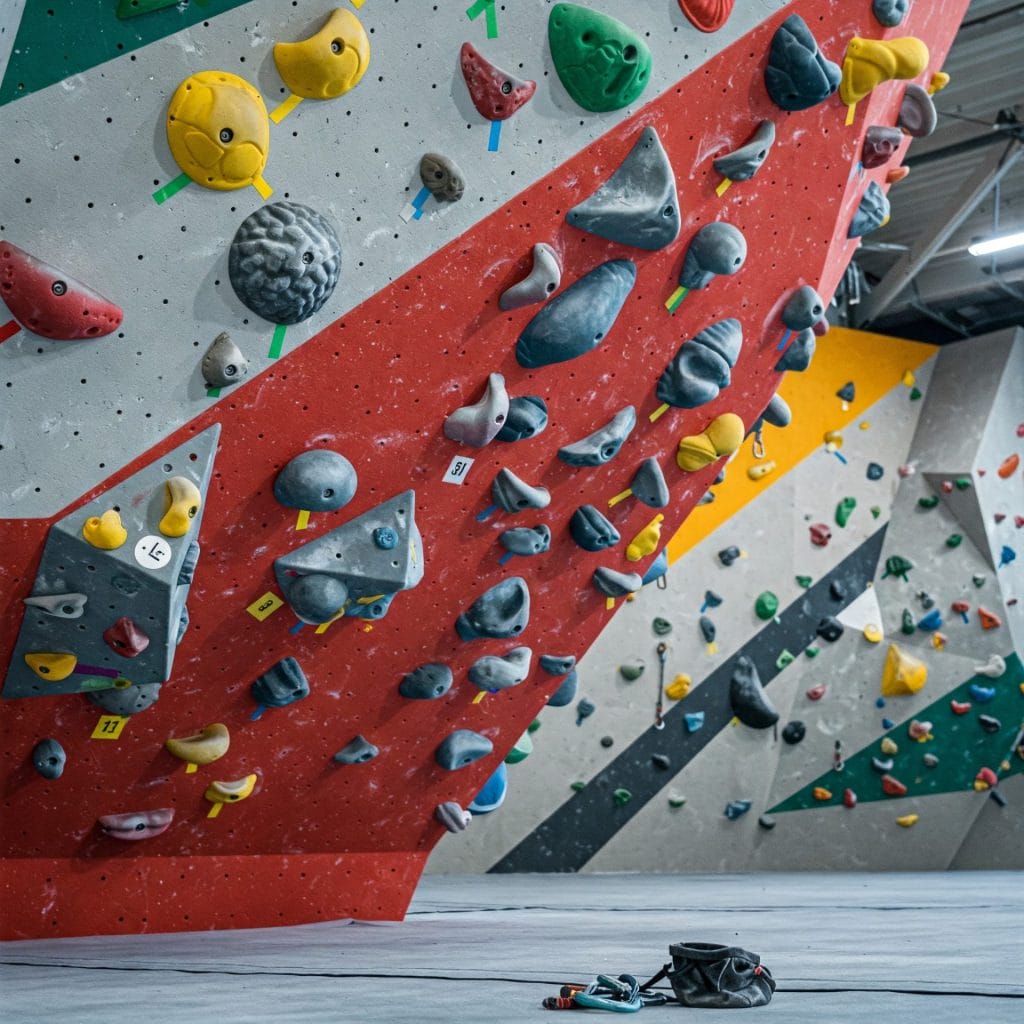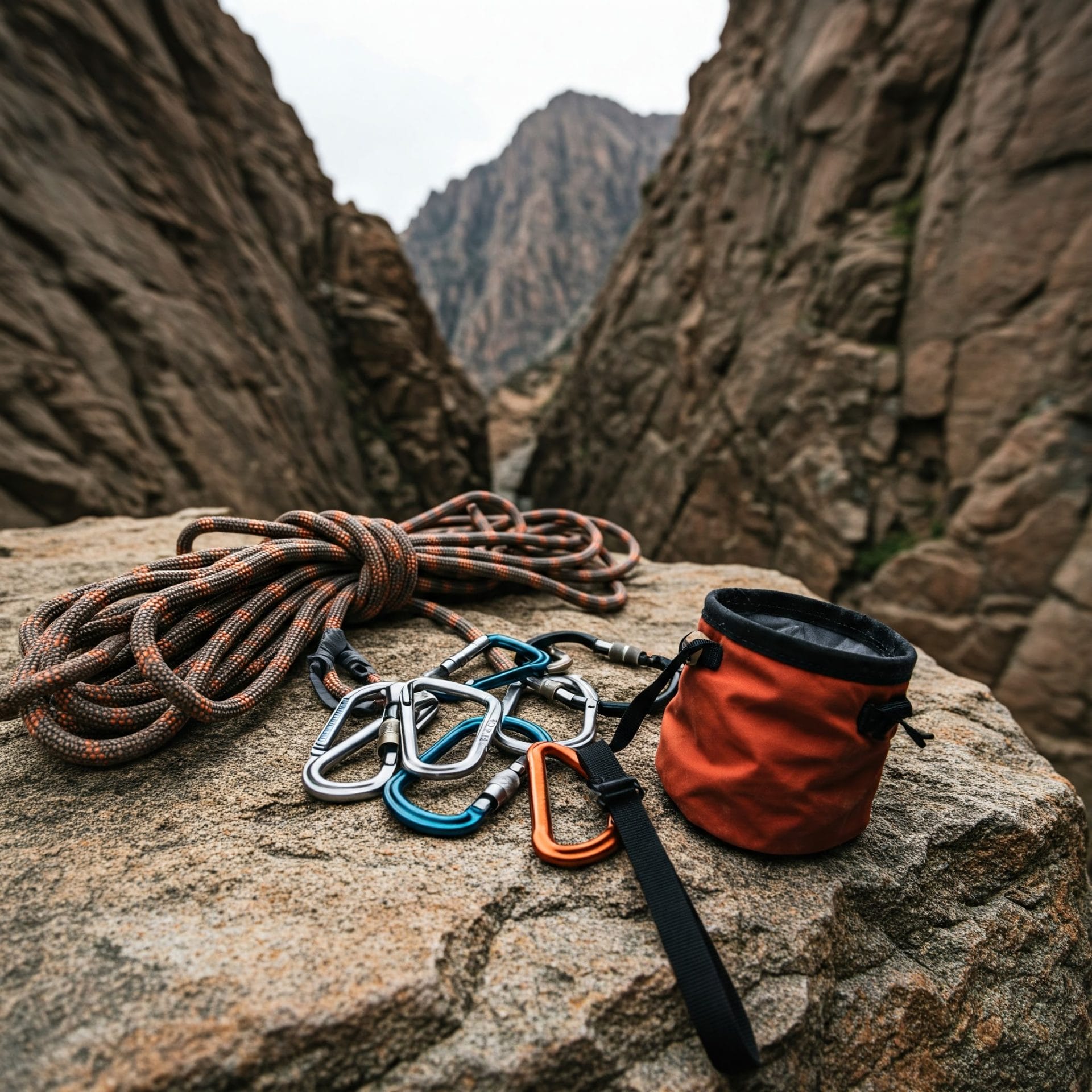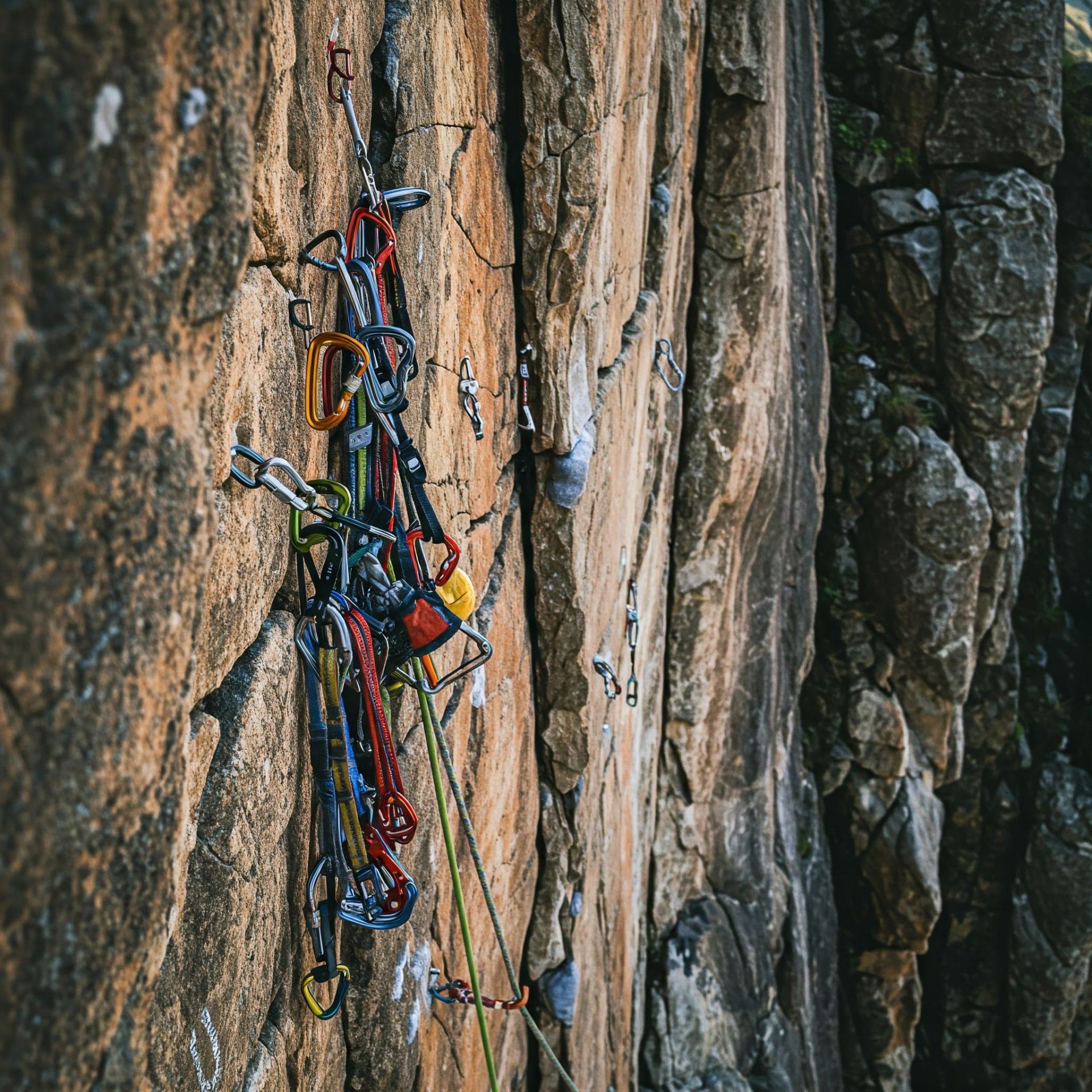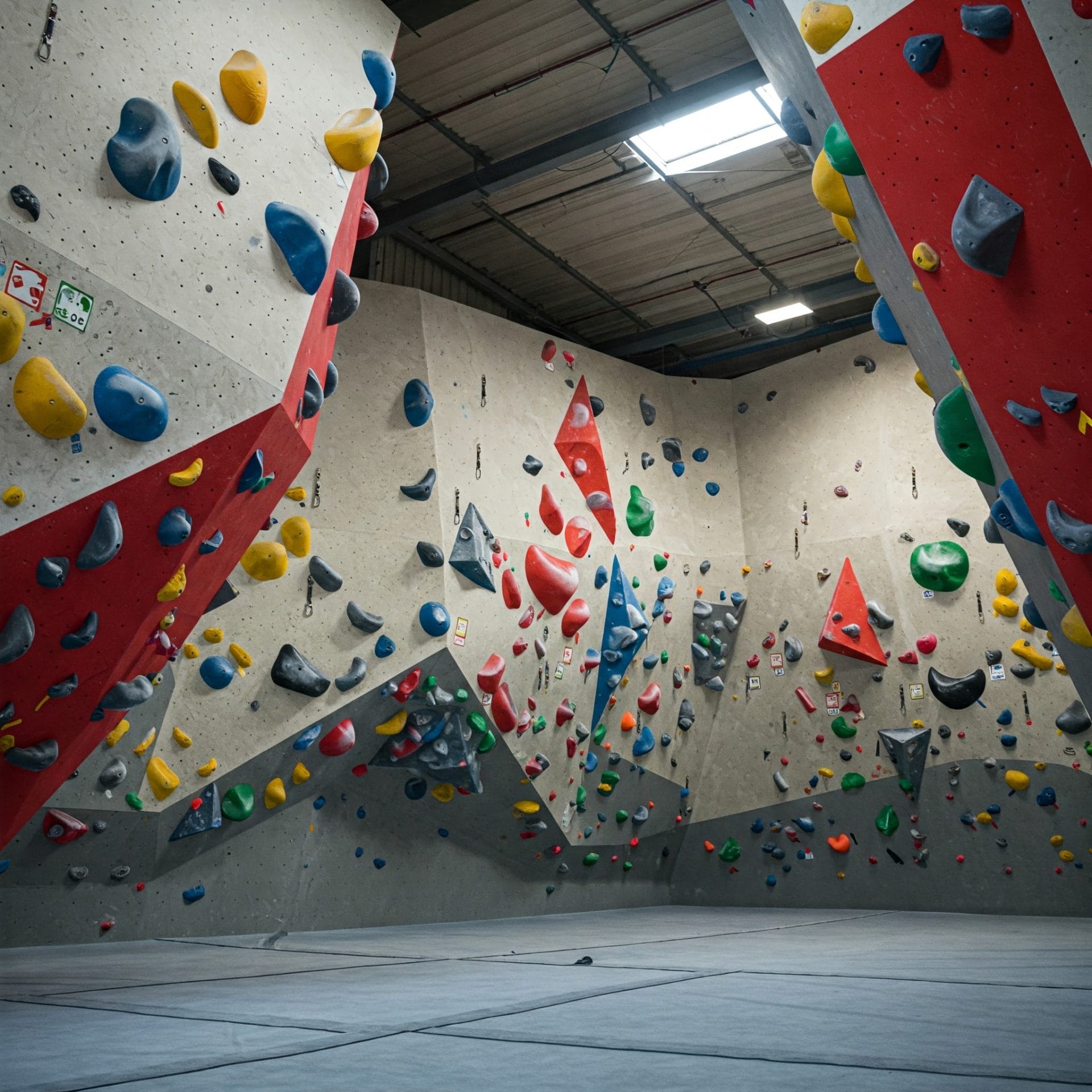Get ready to learn essential climbing words that make climbing safer and more fun!
Basic climbing words serve as the foundation for anyone starting their vertical adventures. From essential gear terms like carabiners (metal loops that connect ropes) and belay devices (tools for controlling rope), to movement techniques such as crimping and flagging, these terms create a shared language among climbers.
The climbing vocabulary doesn’t just sound cool – it keeps climbers safe on the wall. Understanding these basic terms helps new climbers communicate clearly with their partners and navigate routes effectively. The following guide breaks down must-know climbing terminology for beginners who want to join this growing sport.(1)
Key Takeaway
- Climbing gear helps keep you safe while climbing.
- Understanding climbing techniques makes you a better climber.
- Climbing slang helps you connect with other climbers.
Basic Climbing Vocabulary

Climbing Gear
When you start climbing, you need the right equipment. Here are some important climbing words about gear:
- Harness: It’s like a seatbelt for climbing. You wear it around your waist and legs to stay safe. (It keeps you connected to the rope!)
- Carabiner: This metal loop is super important. It has a spring-loaded gate to help you connect things together, like the rope to your harness.
- Belay Device: This cool gadget helps control the rope when someone is climbing. It makes sure they don’t fall too far.
- Quickdraw: It’s two carabiners connected by a sling. Climbers use it to attach the rope to the rock for safety.
- Climbing Shoes: These special shoes fit snugly. They help climbers grip the rock, making it easier to climb.
- Chalk: Climbers use chalk to keep their hands dry. Sweaty hands can slip off holds, but chalk helps with that!
- Handholds: These are the spots on a rock or wall you grab to climb up. There are many different kinds!
Climbing Techniques
Belaying: The Backbone of Climbing Safety
- Belaying is crucial for a climber’s safety, as the belayer controls the rope, ready to catch the climber if they fall.
- The belayer’s job requires focus and precision, adjusting rope tension based on the climber’s movements.
- A good belayer can anticipate when the climber is struggling or needs slack.
- If the rope isn’t controlled correctly, the climber could take a dangerous fall.
Lead Climbing: A Journey of Courage and Control
- Lead climbing involves the climber setting the route by attaching the rope to protection points.
- It requires both physical strength and mental focus, as the climber manages the risk of falling.
- Falls are often longer than in top-rope climbing and can result in swinging or hitting the wall.
Top-Rope Climbing: The Safest Way Up
- Top-rope climbing provides a constant safety net, with the rope anchored at the top.
- It’s less risky than lead climbing, but still requires focus, technique, and stamina.
Footwork: The Key to Efficient Climbing
- Proper footwork conserves energy and maintains balance, often making a big difference in difficult routes.
- Techniques like edging and smearing help climbers maximize their foot placement and efficiency.
Common Climbing Terms
Credit:By Jesse Montgomery
Bolt Climbing
- Bolts are key for safety in tricky routes without natural protection.
- Made from stainless steel, they resist rust in harsh conditions.
- Climbers use quickdraws to secure the rope to bolts as they ascend.
- The spacing of bolts (10-15 feet apart) adds challenge but ensures safety.
- Bolt placement and number affect route difficulty.
Clipping
- Clipping attaches the rope to a quickdraw, ensuring safety.
- Speed and precision matter—too slow or rushed can lead to mistakes.
- Focus on the rope to maintain steady control during clipping.
Whipper
- A whipper occurs when a climber falls after the last protection.
- While scary, it’s a normal part of pushing limits.
- Proper belay and a helmet reduce risks.
Redpoint
- A redpoint means completing a route without falling or resting on gear.
- It’s a rewarding achievement after hard work and practice.
Onsight
- Onsighting is climbing a route without prior falls or beta.
- It requires skill, intuition, and mental focus.
Climbing Slang
Climbing has its own language, full of words with specific meanings that help climbers communicate quickly. Here are some key terms:
- Beta: Helpful advice or tips for a climb. It could be guidance on holds, body positioning, or efficient movements.
- Crux: The toughest part of the climb, where strength, focus, and technique are tested. It’s often a mental hurdle.
- Flapper: A tear in the skin, usually on the fingers, from gripping rough holds for too long. It’s painful but heals quickly.
- Bomber: Reliable, solid holds or gear. When something is bomber, you can trust it completely, which boosts your confidence.
These terms are essential in climbing, helping climbers share experiences and strategies effectively. Embrace them, and the language of climbing will become second nature.(2)
Conclusion
Basic climbing terms serve as the foundation for any climber’s safety and success. Knowledge of essential vocabulary like “belay,” “carabiner,” and “chalk bag” (standard safety equipment) creates clear communication between partners at the crag or gym. The climbing community relies on these shared terms to maintain safety protocols and build connections. Mastering this vocabulary doesn’t take long – most beginners pick up key phrases within their first few sessions on the wall.
FAQ
What’s a “send” in climbing?
When climbers talk about a “send,” they mean successfully completing a climb from start to finish without falling or hanging on the rope. It’s like getting a perfect run – you start at the bottom and make it all the way to the top clean. Climbers might say something like “I finally sent that red route” or “Did you send your project?” Simple as that.
What’s the difference between bouldering and sport climbing?
Think of bouldering as solving short, powerful puzzles close to the ground – usually under 15 feet high. You just need shoes and a crash pad. Sport climbing involves ropes, harnesses, and clips fixed to the wall, letting you climb much higher. It’s like comparing a sprint to a marathon – both are climbing, but they need different gear and techniques.
What does beta mean when climbers use it?
Beta is just climber-speak for information about how to do a climb. When someone gives you beta, they’re sharing tips like “reach left to that crimpy hold” or “heel hook around that corner.” It’s basically insider knowledge about the best way to tackle a specific route. Think of it as a climbing cheat code that experienced climbers pass around.
What’s a crater and why should I avoid it?
A crater is what happens when you fall and hit the ground – definitely something you want to avoid! It usually happens when someone messes up while spotting, belaying, or doesn’t use crash pads properly. Climbers use this term as both a warning and a reminder to always double-check safety systems. Safety first, sending second.
Why do climbers yell “take” while climbing?
When you hear “take!” at the climbing gym, it means the climber wants their belayer to pull the rope tight – usually because they need a rest or are done climbing. It’s like saying “I need a timeout” in other sports. The belayer then takes in the slack, letting the climber sit back in their harness and take a breather.
What’s the deal with grades in climbing?
Climbing grades tell you how difficult a route is, kind of like difficulty levels in video games. In the US, bouldering uses V grades (V0-V16), while rope climbing uses the Yosemite Decimal System (5.5-5.15). Each system starts easy and gets progressively harder. Don’t get too hung up on grades though – they’re more like guidelines than rules.
What does pumped mean in climbing?
Getting pumped means your forearms feel like they’re about to explode. It happens when your muscles get so tired they can barely grip anything anymore. Your forearms fill with blood and feel tight and swollen – kind of like when you carry heavy grocery bags for too long. Once you’re pumped, you’ll need to rest before you can climb effectively again.
What’s a proj or project?
A proj (short for project) is a climb you’re working on but haven’t sent yet. It’s that one route that’s just hard enough to make you come back again and again. Climbers might say “I’m projecting this blue route” or “Want to work on our proj?” It’s like having a nemesis that you’re determined to beat – in a fun way, of course.
References
- https://www.redbull.com/us-en/rock-climbing-terms
- https://theactionsportstranslator.com/blog/rock-climbing-terms/






